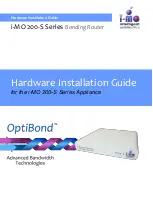
WR1500N
150Mbps Wireless N Router
- 67 -
Appendix D: Glossary
802.11b -
The 802.11b standard specifies a wireless networking at 11 Mbps using
direct-sequence spread-spectrum (DSSS) technology and operating in the unlicensed radio
spectrum at 2.4GHz, and WEP encryption for security. 802.11b networks are also referred to
as Wi-Fi networks.
802.11g -
specification for wireless networking at 54 Mbps using direct-sequence
spread-spectrum (DSSS) technology, using OFDM modulation and operating in the
unlicensed radio spectrum at 2.4GHz, and backward compatibility with IEEE 802.11b devices,
and WEP encryption for security.
DDNS
(
D
ynamic
D
omain
N
ame
S
ystem)
-
The capability of assigning a fixed host and domain
name to a dynamic Internet IP Address.
DHCP
(
D
ynamic
H
ost
C
onfiguration
P
rotocol)
-
A protocol that automatically configure the
TCP/IP parameters for the all the PC(s) that are connected to a DHCP server.
DMZ
(
D
e
m
ilitarized
Z
one)
-
A Demilitarized Zone allows one local host to be exposed to the
Internet for a special-purpose service such as Internet gaming or videoconferencing.
DNS
(
D
omain
N
ame
S
ystem)
–
An Internet Service that translates the names of websites into
IP addresses.
Domain Name -
A descriptive name for an address or group of addresses on the Internet.
DSL
(
D
igital
S
ubscriber
L
ine)
-
A technology that allows data to be sent or received over
existing traditional phone lines.
ISP
(
I
nternet
S
ervice
P
rovider)
-
A company that provides access to the Internet.
MTU
(
Maximum Transmission Unit
)
-
The size in bytes of the largest packet that can be
transmitted.
NAT
(
N
etwork
A
ddress
T
ranslation)
-
NAT technology translates IP addresses of a local area
network to a different IP address for the Internet.
PPPoE
(
P
oint to
P
oint
P
rotocol
o
ver
E
thernet)
-
PPPoE is a protocol for connecting remote
hosts to the Internet over an always-on connection by simulating a dial-up connection.
SSID -
A
S
ervice
S
et
Id
entification is a thirty-two character (maximum) alphanumeric key
identifying a wireless local area network. For the wireless devices in a network to
communicate with each other, all devices must be configured with the same SSID. This is
typically the configuration parameter for a wireless PC card. It corresponds to the ESSID in
the wireless Access Point and to the wireless network name.
WEP
(
W
ired
E
quivalent
P
rivacy)
-
A data privacy mechanism based on a 64-bit or 128-bit or
152-bit shared key algorithm, as described in the IEEE 802.11 standard.
Wi-Fi -
A trade name for the 802.11b wireless networking standard, given by the Wireless
Ethernet Compatibility Alliance (WECA, see http://www.wi-fi.net), an industry standards group
promoting interoperability among 802.11b devices.
WLAN
(
W
ireless
L
ocal
A
rea
N
etwork)
-
A group of computers and associated devices
communicate with each other wirelessly, which network serving users are limited in a local
area.

































